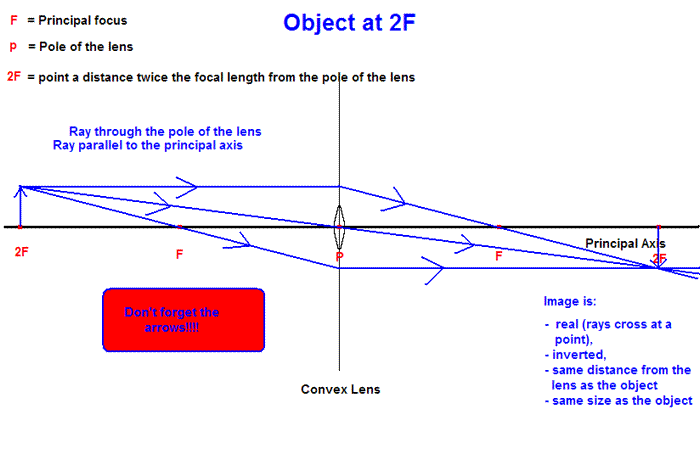 You
should be able to construct the following diagrams:

You
MUST draw these properly - construct them! - sketches will not do!
Use
a ruler and a sharp pencil.
There
are three basic rules to construct an image in an optical diagram:
| 1 |
Rays that pass through the pole of the lens are undeviated. |
| 2 |
Rays that are travelling parallel to and near to the principal axis pass through the principal focus after refraction by the lens (for a convex lens) and appear to emanate from the principal focus (draw in dotted lines) for a concave lens. |
| 3 |
The converse is true, in that rays passing through (or emanating from) the principal focus emerge parallel on the other side of the lens. |
You start off by
drawing the principal axis. This is the horizontal line from which you construct your diagram. Then draw in the lens symbol - in the centre of that line at right angles to it - and mark in
F, P and 2F (these must be drawn to scale!).
Place the object (represented by an arrow pointing to the POINT that you are using for the object -
it is NOT the arrow - you are showing rays from a point forming an image
of a point - the arrow goies to the point from the principal axis) a measured distance from the lens (the height and distance must be to scale- althought vertical and horizontal scales can be different).
We use an arrow because it shows us which way up the image is!
Draw the three rays as instructed above - the point where they cross is the real image. If
they diverge then trace back with a dashed line to the virtual image point. The animations show you how to do this.
Animated examples of how to draw the diagrams
I'll get there soon!
Useful
definitions
-
a
converging lens makes the rays
come to a real focus (cross at a point) it is called a CONVEX lens
-
a
diverging lens makes the rays
appear to be spreading out from a point on the opposite side of
the lens (cross at a virtual point) it is called a CONCAVE lens
-
The principal axis is the line from which all measurements are made in an optical diagram. It is a horizontal line that passes through the paole of the lens or mirror.
-
The principal focus of a convex lens (sometimes called the focal point)
it is the point on the principal axis, through which rays of light,
travelling near to and parallel to the principal axis, pass after
refraction by the lens.
-
The
principal focus of a concave lens
(sometimes called the focal point)
it is the point on the principal axis, from which rays of light,
travelling near to and parallel to the principal axis, apear to
diverge from after refraction by the lens. (they can be traced back
through this point.
-
The
focal length of a lens is the
distance between the pole of the lens and the principal focus. If
the lens has a real focus then the focal length is positive. If
it has a virtual focus it is negative.
-
The
power of a lens is the reciprocal
(1 divided by the number 1/f) of the focal length in metres. It is measured in dioptres (D). The
sign of the power will be the same as the sign of the focal length.
|










